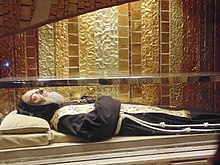San Pio da Pietrelcina
San Pio da Pietrelcina ( Saint Pio of Pietrelcina ) is a pilgrimage church in San Giovanni Rotondo ( Province of Foggia , Apulia ).
history
The church, a huge central building on a shell-shaped floor plan, was built from 1991 to 2004 according to a design by the Italian architect Renzo Piano . Since April 19, 2010 it has been the resting place of St. Pater Pio (1887–1968), Capuchin priest and confessor, who lived in the monastery of Santa Maria delle Grazie in San Giovanni Rotondo from 1916 until his death and is today probably the most popular saint in Italy. His body is exhibited in the lower church in a glass coffin for veneration.
The new building of the pilgrimage site for Padre Pio consists of the forecourt and the church with lecture halls, lounges and over 30 confessionals as well as the lower church, which can hold 1,000 people and is equipped with mosaics by Marko Ivan Rupnik . The pilgrimage church itself has space for 6,500 people; Another 30,000 people can gather in the forecourt.
Renzo Piano aligned the interior of the church with the central altar in terms of room structure and lighting. Sturdy arches made of lime blocks spring from the floor and come together at the altar like in a calyx.
organ
There is an organ each in the upper and lower church . The organ of the upper church was built in 2005 by the organ builder Pinchi. The organ case was designed by Renzo Piano . The slider chest instrument has 78 registers (5,814 pipes) on four manual works and a pedal. The game actions are mechanical, the stop actions are electric.
|
|
|
|
||||||||||||||||||||||||||||||||||||||||||||||||||||||||||||||||||||||||||||||||||||||||||||||||||||||||||||||||||||||||||||||||||||||||||||||||||||||||||||||||||||||||||||||
Remarks
Web links
- Chiesa di Padre Pio 2004, illustrations
- Wooden structures. San Giovanni Rotondo, Santuario di San Pio da Pietrelcina
literature
- Ralf van Bühren : Art and Church in the 20th Century. The reception of the Second Vatican Council ( Council History , Series B: Investigations), Paderborn: Verlag Ferdinand Schöningh 2008, ISBN 978-3-506-76388-4
Coordinates: 41 ° 42 '25.6 " N , 15 ° 42' 10.9" E


